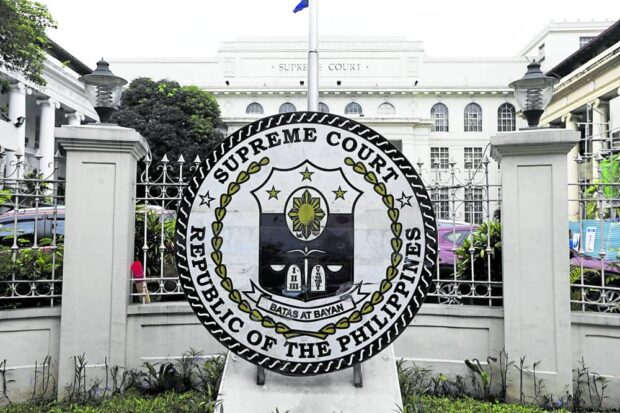SC: MMDA has no power to expropriate private property

The Supreme Court compound (File photo by NIÑO JESUS ORBETA / Philippine Daily Inquirer)
MANILA, Philippines — The Metropolitan Manila Development Authority (MMDA) has no power to expropriate private property for flood control measures, according to the Supreme Court.
In a 15-page decision promulgated on Oct. 11, 2023, but made public only on Wednesday, the high court’s Third Division denied the MMDA’s petition challenging the ruling of the Court of Appeals (CA) that affirmed the unreasonableness of the 10-meter legal easement that the agency sought to impose on the property of Diamond Motor Corp. in Quezon City.
The high court emphasized that the agency’s power was limited to flood control management, including formulating and implementing policies, standards, programs, and projects for an integrated flood control, drainage, and sewerage system.
“Nevertheless, by no stretch of imagination can the foregoing mandate be interpreted to include the greater power of eminent domain,” the Supreme Court said in the decision written by Associate Justice Japar Dimaampao.
The high court defined eminent domain as an “inherent power of every sovereign state vested in its legislature.”
READ: SC stops NGCP project over expropriation row
READ: Over 900 expropriation cases expected as ‘Build, Build, Build’ program proceeds
Property line intrusion
“Pertinently, in every examination of the exercise of eminent domain by a delegated entity, the Court must subject the same to painstaking scrutiny as it involves a derogation of a fundamental right, i.e., that no person shall be deprived of life, liberty, or property without due process of law,” it said.
Citing Sections 3 and 5 of the Republic Act No. 7924 that created the MMDA, the Supreme Court said that the provisions made “no mention at all of the power to expropriate.” The case dates back to September 2007 when Diamond Motor was informed that the MMDA was planning to demolish the floodwall within 10 meters from the strip of the bank of the San Juan River.
Diamond Motor’s automobile store outlet and showroom along Quezon Avenue in Quezon City sit beside the northern bank of the river with the property line, set two and a half meters from the riverbank, demarcated by a concrete floodwall.
Based on court records, the floodwall existed even before the company occupied the property.
The MMDA demanded the imposition of a 10-meter easement against the property for a “road right-of-way” along the riverbank, citing MMDA Resolution No. 3, Series of 1996, and Article IX of Metro Manila Council Ordinance No. 81-01.
Diamond Motor objected to the demolition, saying that it amounted to an intrusion into its property line and that the project could destroy a significant portion of its showroom and the main wall of the outlet store.
The Makati City Regional Trial Court (RTC) Branch 143 initially issued a temporary restraining order against the demotion but eventually denied the application for injunction and dismissed the complaint filed by the company.
Diamond Motor elevated the case to the Supreme Court. In a resolution dated Feb. 6, 2008, the high tribunal issued a status quo ante order mandating the MMDA to refrain from any action while the case was ongoing.
The high court also remanded the petition for review to the Makati RTC to determine the “reasonableness” of the planned 10-meter easement.
In its decision, the Makati RTC Branch 66 ruled that the 10-meter easement was unreasonable, although it authorized the MMDA to enforce a maximum of 3-meter easement following Article 51 of Presidential Decree No. 1067, or the Water Code.
The lower court noted that the MMDA justified its 10-meter easement based on a location plan based on a final report on a study conducted on the San Juan River watershed.
The MMDA sought recourse at the CA, which only concurred with the RTC’s decision that the 10-meter easement had no legal basis.
Power of eminent domain
In its decision, the high court reiterated the earlier decisions of the RTC and CA that no law supported MMDA’s 10-meter easement.
“Petitioner concedes that no statute categorically establishes a 10-meter easement for purposes of flood control. In fact, both the Civil Code and Water Code institute a mere three-meter easement from the bank for public use in the general interest of navigation, floatage, fishing and salvage,” it said.
The Supreme Court further emphasized the underlying basis for imposing the easement, including the location plan, the final report on a study conducted on the San Juan River, and even the 1979 study conducted by the Ministry of Public Works, Transportation, and Communication, “never indicated that the maintenance road to be constructed for flood operations needed to be 10 meters in width.”
In its “final word,” the Supreme Court pointed out that it was not downplaying the magnitude of the worsening flood problem in the National Capital Region, as well as the loss of lives and damage to property brought about by the disaster.
“Certainly, [the] petitioner’s objectives are laudable. But the Court cannot uphold its actions sans legal imprimatur. Should the adjustment of legal easements be deemed necessary, it is the proper agencies granted the delegated power of eminent domain which must act,” it said.